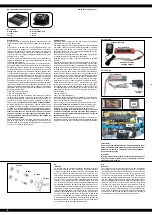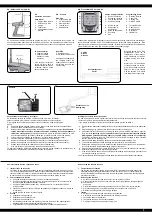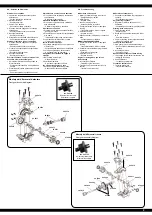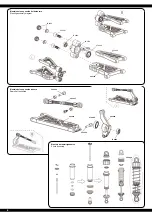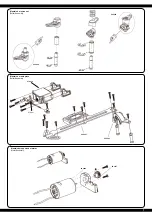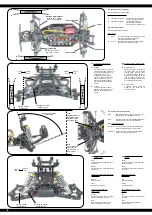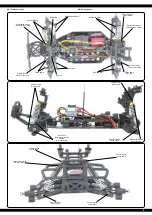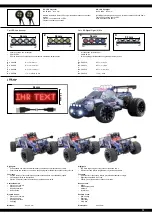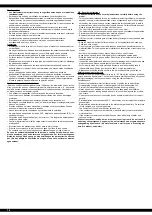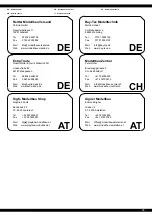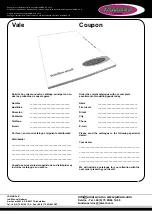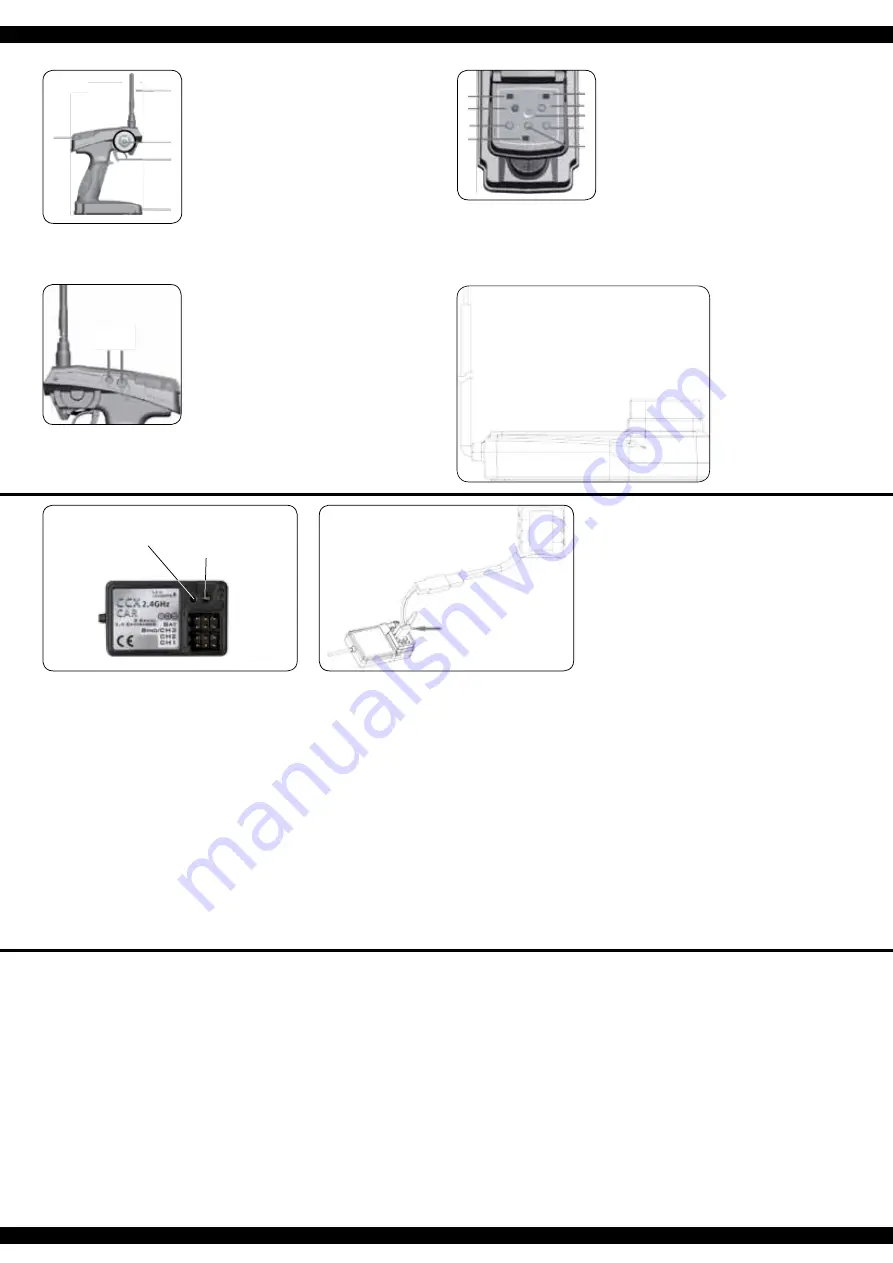
3
ES - Emisora CCX Car 2,4 GHz
GB - Transmitter CCX Car 2,4 GHz
ES
Operación de control
Vista lateral
1. Programación remota
2. Antena de 2,4 GHz
3. Volante
4. Pedal Pulso
5. Compartimiento de las
baterías
GB - Controls
Side View
1. Programming Box
2. 2,4 GHz Antenna
3. Steering Wheel
4. Throttle Lever
5. Battery Hatch
Campo de programación
6. Invertir la dirección
7. Encendido / aleación
8. Trim de la Dirección
9. Enciende y apaga
A. Inversa de gas
B. Compruebe la
alimentación
C. Botón de encendido
D. Dual Rate
E. Gas
Programming Panel
6. Steering Reverse
7. Power LED
8. Steering Trim
9. ON/OFF Switch
A. Throttle Reverse
B. Power Check
C. Binding Button
D. Dual-Rate
E. Throttle Trim
En el teclado de la emisora se permite programar el CCX 2.4 Car de manera fácil y rápida. Los
dos canales pueden direccionar con facilidad a la derecha o a la izquierda con el sistema en los
anuncios indicadores.Com el indicar del cargamento avisa lo cuánto se ha cargado la estación.
Thanks to the logical and well thought out lay-out of the Programming Panel and the positioning of
the switches and LEDs the CCX 2.4 Car transmitter can be quickly and simply programmed. Both
channels can be trimmed and the direction changed. Furthermore the transmitter is equipped with
a Dual Rate system and a red LED indicates the state of the battery charge.
1
2
3
4
5
6
7
8
9
A
B
C
D
E
La parte posterior
F. Canal de recarga
G. Canal que desee
introducir el cable
simulador.
Si se carga en la toma de
carga, por favor, abra la
tapa del compartimento de
la batería. Esto se utiliza
para el enfriamiento.
Rear Side
F. Charge Socket
G. Simulator Cable Socket
If charging the batteries via
the charging socket, the
battery hatch cover should
be removed to ensure suf-
ficient cooling.
G F
2,4 GHz
Antena
Antenna
Receptor/Receiver
061171
Brenda la antena de 2.4 GHz
perpendicular, como en la
fotografía en el lado. Mas no
debe mantenerlo en la parte
metálica, debido a de exten-
sión.
Mount the 2.4 GHz antenna
vertically as shown in the dia-
gram. Do not allow any metal
object to come into contact
with the antenna or to shield
it as this will reduce the range.
Para encender el transmisor y el receptor
En la moderna emisora de 2.4 GHz es necesario que el emisor y el receptor
estén conectados por el módulo. La emisora sólo aceptará la señal su estación.
Si por alguna razón usted tiene que repetir la nueva conexión, haga los siguientes
pasos:
A. Coloque la batería cargada en la emisora o pilas nuevas. Deje la emisora desenchufada.
B. Coloque el cable de conexión de los tres canales.
C. Encender la emisora, mientras haces el bindingde la batería con el receptor.
Depende de la
versión del software, señala su receptor varios modo de binding (en vez de parpadear, la
LED brilla o esta apagado).
El binding es siempre lo mismo en todas las versiones. La LED
en el receptor impieza a parpadear y indica que el receptor no esta en el modo binding.
D. Pulse el botón de encendido de la estación y, al mismo tiempo cambiar el canal.
E. La emisora impieza a parpadear y indica que estas en el modo binding.
F. Quitar el dedo el botón de encendido de la emisora y retirar del enchufe del receptor.
G. Quitar el dedo el botón de encendido de la emisora y retirar del enchufe del receptor.
H. Cuando haga la instalación, tratar de hacer todo correctamente.
I. Si no hay éxito en el procedimiento, vuelva hacerlo todo otra vez.
La siguiente ilustración representa gráficamente el proceso de las unidades, la identificación y la
articulación de los elementos individuales que deben ser operados.
Binding the receiver to the transmitter
As with all modern 2.4GHz R/C systems the receiver must be bound to the transmitter to ensure that
the receiver will only react to signals from that transmitter.
If you wish to re-bind the receiver with the transmitter please proceed as follows:
A. Ensure that the transmitter is fitted with fresh or fully charged batteries and leave the transmitter
off.
B. Plug the binding plug (included) into the channel 3 socket on the receiver.
C. Switch the receiver system on by connecting the battery or turn in a BEC operating on a control-
ler to control.
Depending on your software version of your receiver indicates the different
binding mode (instead of flashing lights for example LED or remains out completely).
The binding process as such is in all versions. The receiver LED will begin to flash indicating
that the receiver is in bonding mode.
D. Press and hold down the binding button on the transmitter whilst switching it on.
E. The transmitter will begin to flash indicating that the receiver is in bonding mode.
F. Release the binding button on the transmitter and disconnect the receiver from the battery or
turn off the controller. Release the binding plug from the receiver.
G. Switch of the transmitter. And remove the binding wire. The system be bound at the next start .
H. Install all properly and check anything very precisely.
I. If the receiver fails to bond or does not function after bonding repeat the above procedure until
a successful bonding is achieved.
The diagram illustrate the bonding process and show the locations of the relevant components.
Enchufe de unión
Binding Plug
Cómo instalar la función a prueba de fallas
1. Instrucciones de la función
La función de la protección de pérdida de control es principalmente para los barcos y carros
r/c y los resguarda de algún daño a través del canal del acelerador. Cuando el receptor está
fuera de la señal de control, el receptor del acelerador volverá a regresar automáticamente a
la posición inicial que se instaló antes de comenzar para evitar la acción de error:
2. Cómo establecer la función
a. Encienda la energía del transmisor y entre a la condición de trabajo
b. Conecte el receptor a la energía y entre a la condición de trabajo, la luz de la señal en
receptor estará parpadeando en todo momento.
c. Controle el acelerador del transmisor y mantenga el servo o el controlador ESC en
posición neutral.
d. Presione el botón de ajuste, el LED va a parpadear por 3 segundos (Véase en la gura de
la izquierda).
e. Suelte el botón de ajuste. Termina el ajuste.
3. Prueba
a. Schalten Sie den Sender ein.
b. Schalten Sie den Empfänger ein.
c. Schalten Sie den Sender aus.
d. Der Empfänger verliert nun das Signal und fährt den Servo bzw. den Speedregler am
Gaskanal auf die zuvor einprogrammierte Position zurück.
e. Folgt der Ablauf den obigen Schritten funktioniert die
FailSafe-Funktion korrekt.
How to setup the fail safe function
1. The instruction of function
The function of protection of losing control is mainly for r/c boats and cars and keeps them
away from damage through throttle channel. When the receiver is out of control signal, the
receiver of throttle will automatically return to the initial position which set up before starting to
avoid the error action :
2. How to set the function
a. Switch on the transmitter power and enter into the working condition
b. Connect the receiver with power and enter into the working condition, the signal light on
receiver will blink
all the time.
c. Control the throttle of transmitter and keeps the servo or ESC in the neutral position.
d. Press the setting button, the LED will be flash for 3 seconds (see on pict. left).
e. Release the setting button. The setting is finished.
3. Testing
a. Switch on the transmitter and enter the working condition.
b. Contact the receiver with power and enter the working condition.
c. Turn off the power of transmitter.
d. The throttle of servo will be set automatically.
e. Finish these steps above means the setting is ok.
LED
Setup
Fail Safe


